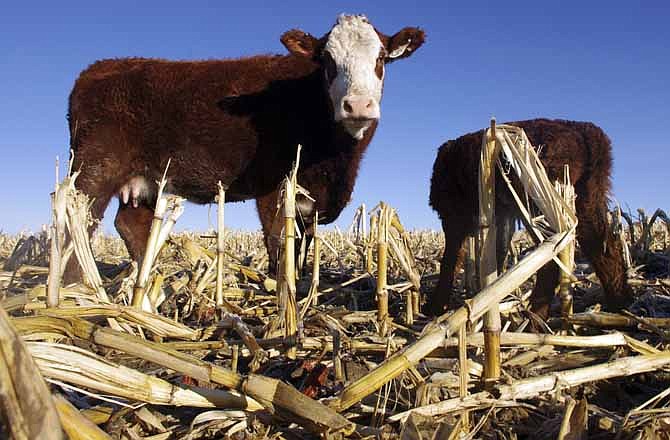Livestock farmers are demanding a change in the nation's ethanol policy, claiming current rules could lead to spikes in meat prices and even shortages at supermarkets if corn growers have a bad year.
The amount of corn consumed by the ethanol industry combined with continued demand from overseas has cattle and hog farmers worried that if corn production drops due to drought or another natural disaster, the cost of feed could skyrocket, leaving them little choice but to reduce the size of their herds. A smaller supply could, in turn, mean higher meat prices and less selection at the grocery store.
The ethanol industry argues such scenarios are unlikely, but farmers have the backing of food manufacturers, who also fear that a federal mandate to increase production of ethanol will protect that industry from any kind of rationing amid a corn shortage.
The subject of debate is the Renewable Fuel Standard, a 2005 law requiring the nation to produce 7.5 billion gallons of renewable fuel by 2012. The standard was changed in 2007 to gradually increase the requirement to 36 billion gallons by 2022.
While a $5 billion-a-year federal ethanol subsidy is scheduled to expire this year, the production requirement will remain, unless it's changed by Congress.
That has other corn consumers worried that if production falls and rationing is needed, ethanol companies will be exempt. The U.S. Department of Agriculture recently reduced its estimate of this year's corn crop because of flooding in the Midwest and drought in the southern plains, and corn reserves are expected to fall to a 20-day supply next year. A 30-day supply is considered healthy.
At the same time, the price of corn for livestock feed has risen from an average of just over $3 a bushel in 2006-07 to an average of more than $6 this year.
"If we get a short crop, the ethanol industry does not participate in rationing and the brunt will fall on livestock and poultry," said Steve Meyer, president of Paragon Economics, a livestock and grain marketing and economic advisory company in Adel, Iowa.
A bill introduced last month by Rep. Bob Goodlatte, R-Va., would partially waive the ethanol goals when corn inventories are low.
The Grocery Manufacturers Association, which represents more than 300 food and beverage makers, also has endorsed the bill.
"We're behind livestock producers on this issue," said Geoff Moody, the association's director of energy and environmental policy. "We believe if there is a need to ration that ethanol will eat first because of the mandate."
About 5.9 billion bushels of corn were used for animal feed last year; 2.4 billion were exported; and about 4.9 billion were used for ethanol, up from about 630 million bushels in 2000, according to the National Corn Growers Association. About 1 billion bushels were eaten by humans in products such as cereal, sweeteners, and beverages.
U.S. corn farmers have steadily increased production over the years thanks to hybrid seeds and improved techniques, but Meyer said a 20 percent decline in the harvest would be enough to force corn rationing and lead to feed shortages. That would leave livestock farmers with little choice, he said.
"We can't shut down feeding," Meyer said. "The only way to do that is to kill the animals."
Even if there's no rationing, ethanol manufacturers generally have been better able to cope with high corn prices than livestock farmers because their business has bigger profit margins, said Darrel Good, an agricultural economist at the University of Illinois.
Randy Spronk, who raises corn and hogs in Edgerton, Minn., said farmers don't want to attack the ethanol industry but they want a plan in place if the corn supply should drop significantly.
"We really don't want to attack ethanol but wise people make plans," he said.
Matt Hartwig, chief of staff for the Renewable Fuels Association, called the effort to rewrite the fuel standard law "little more than a Trojan horse effort" to weaken or even eliminate it. He said the farmers' complaints were overblown and most livestock producers and meatpacking companies were making good profits.
Also, the ethanol industry now produces about 1 billion gallons of ethanol more than is required and if corn supplies fall short, it could cut back, he said.
The Environmental Protection Agency, which administers the fuel standard, said in a statement that states can already ask for a waiver "under certain circumstances, including inadequate domestic supply or harm to the economy or environment of a state."
Texas Gov. Rick Perry did this in 2008, claiming rising corn prices were hurting ranchers in his state. The EPA said it denied the request because the quota for renewable fuel wasn't causing severe economic harm to the state.
Meyer said many farmers are skeptical about a process that leaves such decisions to the EPA administrator, who "many in agriculture believe won't consider the best interest of livestock."
Good, the University of Illinois farm economist, said meat supplies could tighten if competing demands force corn prices higher. He said it boils down to a simple choice: "We're going to have to reduce our rate of increase in corn consumption or we're going to have to produce more corn."

